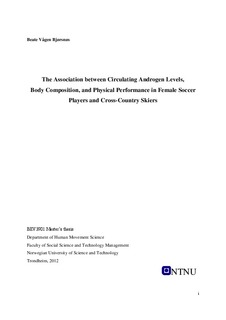| dc.description.abstract | Background: In recent research, links have been found between androgens and anabolic body composition. Some findings suggest that androgen hormones in female athletes are positively associated with both power and aerobic performance, while other studies have found that body composition is associated with aerobic performance. The study is intended to investigate the association between circulating androgen levels, body composition, and physical performance in female athletes.
Methods: This research consists of a cross-sectional study of 34 high-level Norwegian female athletes aged between 18 and 34 years (mean 22 years). The participants consisted of 25 soccer players and 9 cross-country skiers. For physical performance examinations, VO2 max tests on treadmill were conducted, and squat jumps on a power platform. Lactate concentration after VO2 max test was also measured. Bloods samples were drawn after an overnight fast. Free testosterone index (FTI) was used as androgen variable in the analyses. DEXA scans were used to estimate body composition.
Results: The analyses did not show statistically significant associations between FTI and body composition, or between FTI and physical performances. Some significant associations were found between the body composition variables and the physical performance measures. The soccer players and cross-country skiers were similar to each other in terms of androgen levels, age, height, and lean body mass (LBM), but statistically significant differences were found in fat percentage, weight, body mass index (BMI), and performance on squat jump power and VO2 max. Compared to cross-country skiers soccer players developed significantly more power in the squat jump (p = 0.01), but not in squat jump height (p = 0.21) while cross-country skiers performed better on VO2 max test (p<0.001). Fat percentage was negatively associated with squat jump height in soccer players (β = -0.551, p = 0.016). In regression analyses fat percentage and LBM were negatively associated with oxygen consumption in cross-country skiers (β -1.144, p = 0.043 and β -1.251, p = 0.045).
Conclusion: The most important finding in this research is that androgen levels, given by FTI, are not associated with either body composition or physical performance. This contradicts previous research. The statistically significant associations found among the participants were related to sport discipline and body composition.
Keywords: Female athletes, circulating androgens, physical performance, body composition. | nb_NO |
